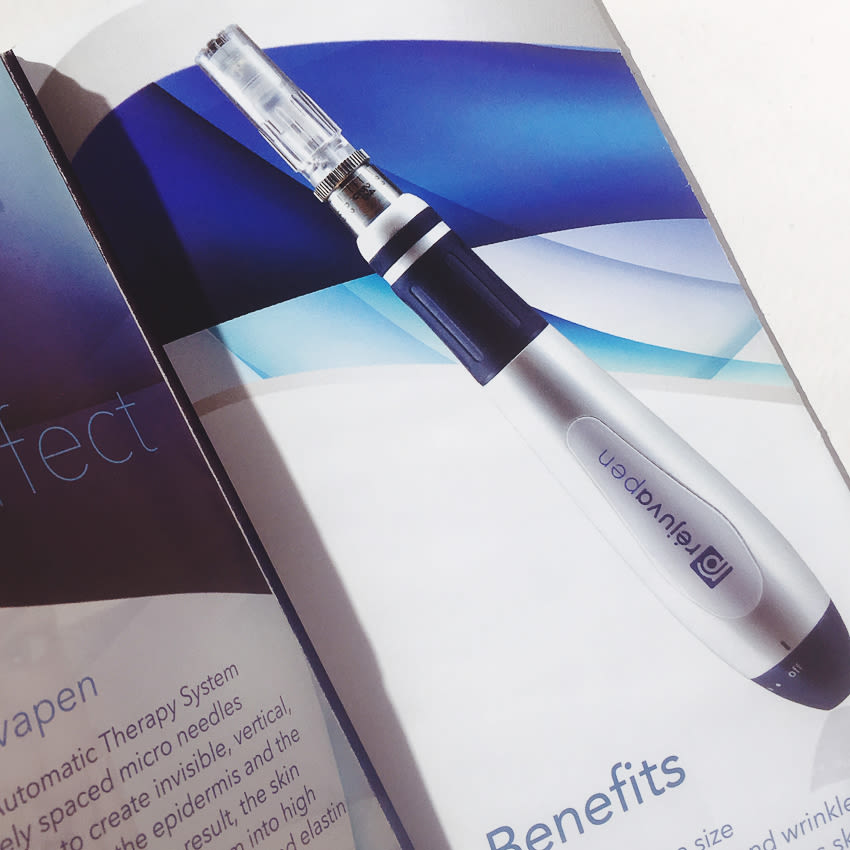I'll preface by saying this: not everyone is the ideal candidate for professional microneedling. I learned this a little too late—when I was already straight-jacketed into a chair at Dr. Doft's plastic surgery office in front of medical aesthetician Yurga. (Yes, that Yurga.) She looked at me and started slowly explaining the process of microneedling because, as she said, "I want to make sure this is actually what you want to do."
Seeing as I had made the appointment and skipped out of work early to Uber myself uptown to Dr. Doft's office with a very chic address, I was going to will this to happen no matter how crazy everyone thought I sounded. (Mainly my mom. Hi, Mom. I'm fine.) Yurga could tell I was nervous—and she didn't even know I'd rescheduled the appointment three times. When booking, I was told not to drink alcohol or take any Advil for the two weeks leading up to the procedure to reduce the risk of bruising. First, I rescheduled for after the holiday season, when alcohol is all but unavoidable; then two different times when headaches drove me into ibuprofen's warm embrace. Not for nothing, I'd also heard from a friend that it was the most painful thing she'd done to her face (and she's done a lot to her face)—but totally worth it. After all the rescheduling, I still almost cancelled. My siren's call to beauty journalism, the most noble of professions, was the only thing that stopped me.
In my defense, on paper, microneedling is actually terrifying. The gist is that a mechanized device with a bunch of spinning needles is rolled over your face to punch tiny holes in your skin. These "controlled punctures" force your face (or wherever you do it) into repair mode, meaning you start rebuilding your own collagen and elastin to heal the micro-injuries. If it's done correctly, wrinkles and acne scars are said to disappear—the latter is what brought me in. I have a pesky bump of scar tissue right by the sprouts of my left eyebrow thanks to a particularly nasty cystic zit years ago. I'm sure it'll go away eventually, but I'd gotten impatient and zeroed in on this for a quicker fix. Yurga said that I might not see a demonstrable difference, that the best candidates for microneedling are those with visible lines and a lot of surface scarring. (Take a look at the befores and afters—they're really ace marketing.) Hence why Yurga looked at me like I had a third eyeball when I sat down in her office. Not everyone needs professional microneedling—but it's not so harmful that'll ruin your face either. We decided to go ahead with it anyway.
I'm happy to report that the actual needles are not nearly as painful as I expected. Not even close, thanks to the heavy layer of lidocaine Yurga applied to my face for 15 minutes before powering up. What did hurt was the extraction she did right before—but for good reason. You shouldn't microneedle over any active blemishes or else you risk driving that bacteria deep into the rest of your skin. Even more reason to go to an office where you're absolutely, 100%, positively sure they know what they're doing. (And if you're asking yourself, "But isn't this an at-home thing?" you'll find the answer to that here. There are very few things we as an editorial team have come down hard on—this is one of them.)
Yurga passed over each area on my face three times—horizontally, vertically, and diagonally. The whole thing probably took 10 minutes. The immediate results are a tomato-red, super numb face, which is pretty easily subdued with some light therapy and a chilled sheet mask. Oh, and about a gallon of Hydra-Boost calming serum, chock-full of zinc, copper peptides, hyaluronic acid, and arnica. Apparently you can layer this stuff on close to every 30 minutes after finishing a round of microneedling and your skin will continue to drink it up—I did not find that to be the case. But I took that to mean that Yurga did a good enough job slathering it on in-office. By the time I got home, my skin felt so full of moisture that I could burst it like a water balloon. Instead, I felt like I had to drink a lot of water. So I did that, but with a straw because my face was still numb.
Coming down off the lidocaine was the least fun thing about this endeavor actually. You know that feeling of numbness after a dentist visit—it's hot and cold and slack and you're totally aware that it's there? It's like that. But your entire face instead of just near your molars. Microneedling is not a quick thing to do on your lunch break. After you microneedle, go home! Watch a movie, but stay upright to prevent bruising. You'll be less red and tingly and hot and nauseous in the morning, I swear.
That's kind of the fun part: waking up and seeing what your face looks like. I was much, much, much less red—really almost back to normal. And no bruising! Where Yurga had done the extraction was probably the worst part, but it was confined to one red scab. The scar tissue I mentioned is still there, but it'll take a couple whirls with the needle to get rid of that deep-set sucker. And I don't even notice it now, mainly because my overall texture is sort of like that water balloon still. Tight, shiny (because of the hydration), and plump. What was even better? The zit Yurga extracted healed in record time. Like two days. It was insane. Such is the power of human-made collagen. It's just a pain to get it to do what you want.
—Emily Ferber
Photographed by Tom Newton.

